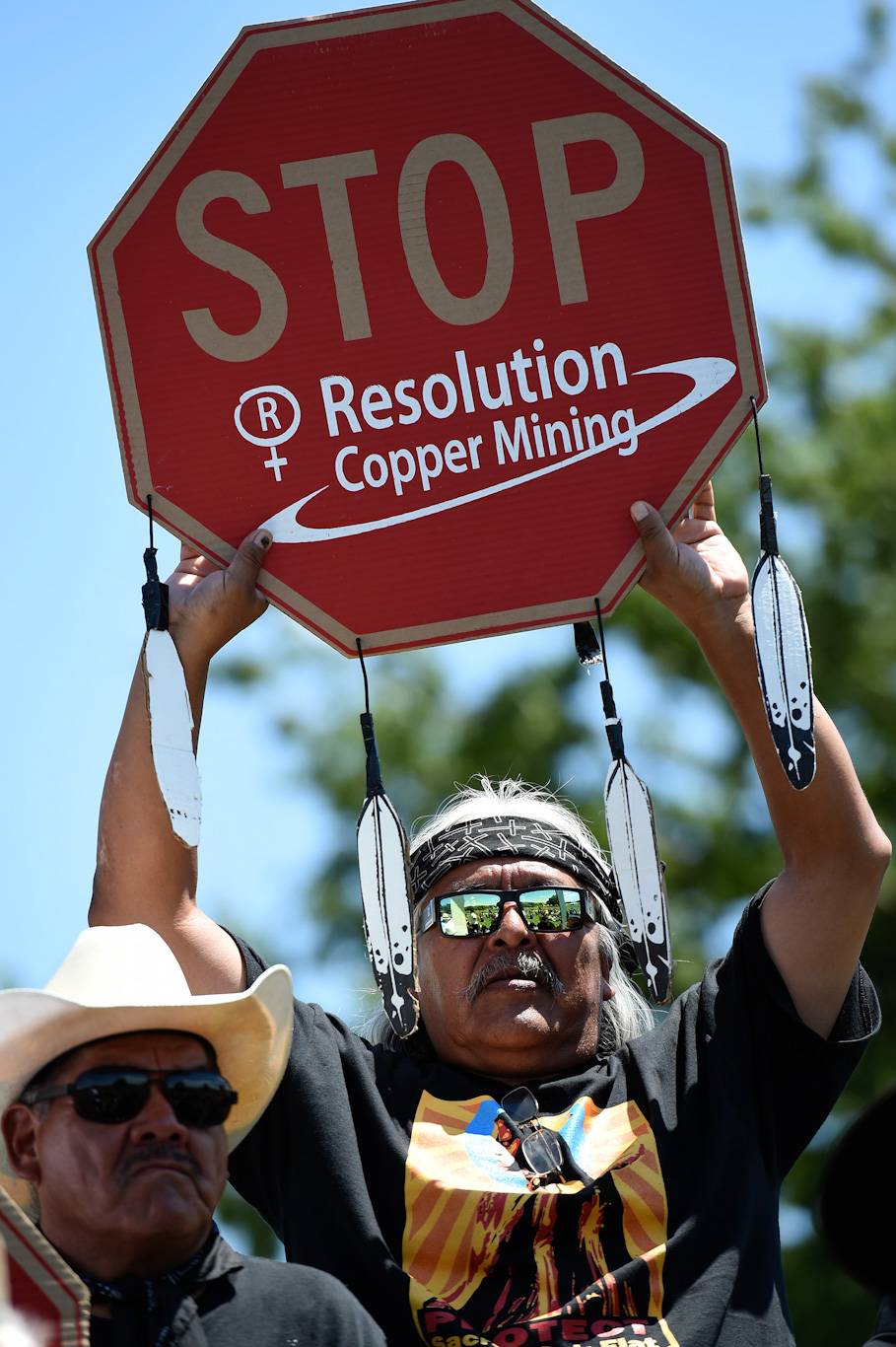The land swap deal between the U.S. government and British-Australian corporate mining giant Rio Tinto and its subsidiary, Resolution Copper, went into effect last week. But, the true Native owners of the land are not about to give up a battle they have been fighting for centuries.
On Friday, January 15, the U.S. Forest Service, under pressure of the outgoing Trump administration, published the Final Environmental Impact Statement (FEIS) pertaining to the transfer of the 2,500 acres of disputed territory in the Tonto National Forest in Arizona to the Resolution Copper Mine, which when complete will become the largest copper mine in the world.
The publication of the FEIS triggers the land swap, according to federal law despite a lawsuit filed on Tuesday, January 12 by Apache Stronghold on behalf Apache religious and cultural leaders calling for a temporary restraining order against the publication of the FEIS. Last Thursday, Obama-appointed District Court Judge Steven P. Logan denied Apache Stronghold’s request, allowing the FEIS to move forward.
Apache Stronghold also filed a lien to stop the transfer “on the grounds that the giveaway and destruction of Oak Flat violates the Religious Freedom Restoration Act and Apaches’ constitutional rights to religious freedom, due process, and petition and remedy, and is a breach of trust and fiduciary duties.”
With Rio Tinto seemingly in the driver’s seat to forge ahead with the planned copper mine, which is projected to produce over 40 million tons of copper over its lifetime, the historical and persistent betrayal of the federal government’s word when it comes to its formal agreements with First Nation peoples is once again on full display.
In the complaint filed in the Phoenix Division of the District Court of Arizona against the Secretary of the U.S. Department of Agriculture and three other defendants, the Apache nation demanded a jury trial to prove that the United States does not own the land it is transferring to the mining company, citing a treaty signed and ratified nearly two centuries ago.
The lost treaty
In the summer of 1852, Apache Chiefs Cuentas, Azules, Blancito, Negrito, Capitan Simon, Capitan Vuelta, and Mangas Coloradas, met with the military governor of New Mexico, Edwin Vose Sumner and the Superintendent of Indian Affairs, John Greiner, 60 miles west of Albuquerque, New Mexico in Acoma Pueblo to sign what is known as the Treaty of Santa Fe.

The compact was ratified by the U.S. Senate and proclaimed by President Franklin Pierce a year later. In it, the various tribes of the Apache nation agreed to release the captives taken during the Apache Wars and permit the establishment of American military forts and trading posts within tribal boundaries among other stipulations designed to bring the Apaches to heel. However, the question of land ownership is never addressed in the 170-year-old document.
Jeffrey P. Shepherd, Professor of American Indian History at the University of Texas at El Paso (UTEP) called it the “Lost Treaty” due to the meager attention it has received by scholars and advocates over the years. But with the Oak Flat land swap between the United States and Resolution Copper moving forward, the Treaty of Santa Fe has become a focal point in the fight to keep the land and water rights of the Western Apache nations from falling into the hands of the Anglo-Australian mining company.
Piercing betrayal
As stated in the lawsuit by Apache Stronghold, “Evidence exists that the “Oak Flat Parcel” within the proposed “Southeast Arizona Land Exchange and Resolution Copper Mine Project” which—quite possibly as soon as January 15, 2021—is to be conveyed away by the Defendants to the foreign mining conglomerates Rio Tinto and BHP via their joint subsidiary Resolution Copper Mine, is not owned by the Defendants.”
According to Archeologist John R. Welch, there is indeed no evidence that the United States ever took legal possession of the territory of Oak Flat. In his lengthy 2017 analysis of the treaty, Welch thoroughly examines the only treaty executed between the Apache Indians and concludes that he found “no evidence, in the proceedings of the Indian Claims Commission or elsewhere, of any change or diminishment in the Apaches’ reserved treaty rights to the Western Apaches’ Treaty Territory.” Welch further states unequivocally that “Oak Flat is Apache land, as it has been for centuries and is not owned by the United States of America or any other entity or person.”
Despite the publication of the FEIS and its implications, the fight for Oak Flat is just beginning and there are still many avenues to pursue that can put a halt to the copper mine. Randy Serraglio of the Center for Biological Diversity told The Guardian that “there are plenty of things an incoming Biden administration can do to stop this,” and offered hope that there was “no guarantee they will be able to get any of the other federal permits to actually do the mine.”
But Native Americans have gone too long relying on hope that rarely, if ever, pans out when it comes to the deals it makes with the U.S. government. The 1852 treaty is a case in point and only one of the many examples of U.S. government perfidy. In his inaugural speech of 1853 barely months before the ostensible framing into law of the Treaty of Santa Fe, Franklin Pierce delineated his expansionist policy in no uncertain terms announcing that his administration’s push for manifest destiny would “not be controlled by any timid forebodings of evil”.
Feature photo | Apache activist dancer performs in a rally to save Oak Flat, land near Superior, Ariz., sacred to Western Apache tribes, in front of the U.S. Capitol in Washington, July 22, 2015. Molly Riley | AP
Raul Diego is a MintPress News Staff Writer, independent photojournalist, researcher, writer and documentary filmmaker.


